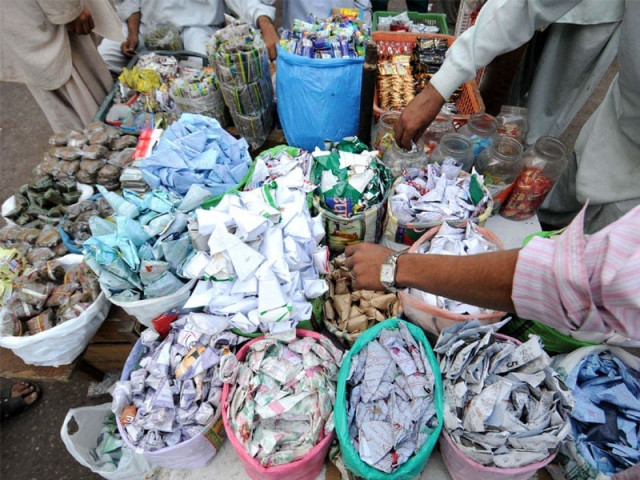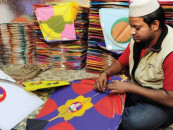Gutka: Taste for the toxic
Even though sale of gutka was banned in Sindh last year, its sale and consumption is still rampant.

Gutka: Taste for the toxic
Aqib* looks like a picture of health, until he smiles and reveals his crimson-stained teeth. The 23-year-old is addicted to gutka — a hazardous concoction of areca nut, tobacco, slaked lime, catechu, artificial colour and flavourings. A taxi driver by day and a security guard by night, Aqib works hard to make ends meet in Karachi and survives on merely four hours of sleep every day.
He is fully cognizant of the damaging effects of gutka consumption on his health and cringes at the thought of his son getting hooked to it, but he still can’t seem to break a habit he has had for nine long years.
“I simply can’t live without it because it keeps me active and helps me work better,” he admits. “And it’s difficult to quit when it’s available everywhere and everyone is using it.”
Aqib is one of the countless gutka addicts in Sindh. Even though the provincial government banned gutka in December 2011, imposing a penalty of Rs20,000 and jail term of up to six months for violators, the implementation of this law has been ineffective. Thus, the product continues to be sold openly at pan shops and other outlets.
Harmful effects of gutka
Many studies have proven a correlation between prolonged usage of betel, areca and smokeless tobacco — components of gutka — and oral submucous fibrosis, oral cancers, leukoplakia and other head and neck malignancies. The hazardous effects of gutka have been documented even by local experts. A three-year-long scientific study, which culminated in 2010, found traces of toxic metals in 250 samples of products containing betel nut — gutka, supari, mainpuri, mawa, pan and sweet supari.
Conducted by Muhammad Tahir, Dr. Akhtar Shareef and Farooq Ahmed Khan — scientists at the Pakistan Council of Scientific and Industrial Research — the research found unhealthy amounts of copper, cadmium, lead, nickel, iron, chromium, manganese and zinc in these products. “These metals taken in large amounts are toxic and can have serious and long term ill effects and even lead to oral cancer,” says Tahir.
And it’s not just the rising numbers of oral cancer patients that gutka is responsible for. Experts say that the prevalence of many other illnesses in Karachi — for example, erythroplakia, leukoplakia, oral submucous fibrosis, reproductive problems and a list of other types of cancer — are also linked to gutka usage.
Prevalence of gutka consumption
Karachi has seen a massive rise in the number of users of this dangerous mixture, which is directly responsible for increasing incidence of oral disease in the city’s population. The latest figures are not available but according to a 2002 study on Karachi, starting from 1 January 1998 to 31 December 2002, 21.3% men and 19.3% females in 100,000 population were reportedly suffering from oral cavity cancer — among the highest rates in the world.
And what’s particularly disturbing is that gutka, due to its low price, is even used by young children, making them vulnerable to a host of oral maladies.
“According to a recent research, 7% of primary school children in Karachi consume gutka,” says Dr Qaiser Sajjad a renowned ENT surgeon and Finance Secretary of the Pakistan Medical Association Centre. Research conducted in the Ibrahim Hyderi coastal area of the city yielded even more disturbing results. “Nearly 96% women there have picked up the habit of consuming gutka before breastfeeding, in order to make their children sleepy, thus transferring all its ill effects to their newborn baby,” adds Sajjad, who has been active in the fight against gutka use.
And this poisonous concoction is being sold openly as ‘pan masala’ in every nook and cranny of Karachi, with a price range as low as Rs1-18.
Gutka is usually made at homes or at companies registered as manufacturers of pan masala. A gutka seller from Manghopir, who wishes not to be named, admits that he used to prepare it at home with a few other family members, until the ban was imposed last year. But he still continues to sell the mixture. According to him, the areca nut chalia he used for preparing gutka was of a very inferior quality and had different addictives substances — including heroine and opium — mixed in it to keep the person hooked to his brand.
He reveals that the gutka prepared at factories is even more injurious than the home-made version. “They have found a cheaper replacement for katha (catechu). The blood that collects at the butcheries at the end of the day, is packed in large bags and delivered to them daily and then used to thicken the mixture,” the gutka seller discloses. This makes the already lethal mixture even more poisonous.
Is the police missing in action?
“The police is actively dealing with this problem, but they are overburdened with the three major issues in Karachi — target killing, bank robberies and the law and order situation,” says Saud Mirza, former CCPO Karachi. “I feel that the anti narcotics force and the excise and taxation force should be utilised to deal with this problem.”
However, Dr Syed Saifur Rehman, the Central Karachi Deputy Commissioner, has a different viewpoint. “We are working on a war footing to eradicate this problem, but it is so deep-rooted that it will take a lot of time, effort and public support,” he says.
The official says that his subordinates have confiscated more than 400 kilograms of gutka and registered FIRs against 39 persons since after the imposition of the selling of gutka and mainpuri. “The gutka that we confiscated had high volumes of heroin in it as well,” he declares.
Despite these measures, the menace of gutka continues to plague us. At countless pan joints in cities and towns across Pakistan, you will spot youngsters like Aqib who continue to chew this lethal concoction and invite disease, disfigurement and ultimately, an untimely death.
*Names have been changed.
Published in The Express Tribune, March 21st, 2012.



















COMMENTS
Comments are moderated and generally will be posted if they are on-topic and not abusive.
For more information, please see our Comments FAQ